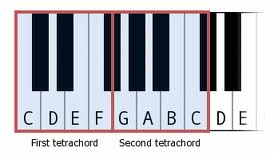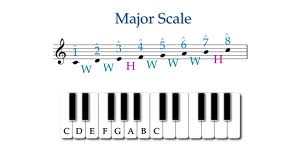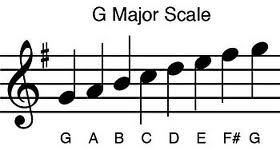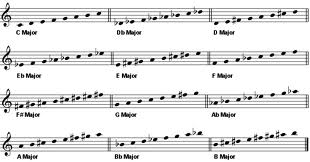Tetrachords and major scales are nothing more than a repeating pattern. As you may have guessed, the word “tetra” means four.
Whenever you see a tetrachord, there will always be four notes present in the grouping.
| ✅ The best self-study music theory book loved by all my readers and students. |
Tetrachords
Let’s begin by defining what a tetrachord is. A tetrachord is a series of four notes that have a specific pattern of whole steps and half steps.
The pattern I’m talking about looks like this: whole step – whole step – half step.
Another important thing to remember is that the four notes of the tetrachord must be in alphabetical order using the musical alphabet (A-B-C-D-E-F-G).

When we put two tetrachords together, we have a major scale.
Major Scales
A major scale contains a total of eight notes or two tetrachords joined together by a whole step.
Now our pattern of whole steps and half steps looks like this: whole step – whole step – half step – whole step – whole step – whole step – half step.

Every scale always begins and ends on the same note that is used to identify the name of the major scale.
For example, if you want to play a C Major scale, your first note will be C.
Scales can start on any note giving us a total of 12 major scales. They are C, G, D, A, E, B or Cb, F# or Gb, C# or Db, Ab, Eb, Bb, and F.
Scale Degrees
Each note of a major scale is assigned a number called a scale degree. There are eight degrees in a major scale.
The first note will always be “1”, second note is “2”, third note is “3”, and so on until you get to the last note which is scale degree number “8”.

As you can see, the C Major scale contains a half step between the 3rd and 4th scale degrees and the 7th and 8th scale degrees. The rest of the scale degrees contain a whole step in between them.
Why Do I Need To Know This?
It’s important to know about tetrachords and how they create our major scales so that you have the skills to figure out any major scale you want to play.
You may be in a situation where you don’t have a scale sheet listing all of the major scales for you and maybe knowledge about the circle of fifths is just too confusing right now. There is still another way to figure it out!
We can continue problem-solving the notes of every scale by using the memorized pattern of whole steps and half steps that make up each tetrachord and major scale. Wa-hoo!
Practice
The best way to understand this is to practice it on paper using several different scales. Let’s try an easier scale first.
- Using treble clef, try creating the G major scale by writing out the first tetrachord.
- Now write out the second tetrachord on paper.
- Finally, join the two tetrachords together with a whole step to produce the G major scale.
How did you do? It should look something like this…

Keep using the steps above to practice writing out each scale. The rest of your major scales should look like this:

Now that you know more about tetrachords and major scales, you are well on your way to reading and playing music successfully.
It’s important to understand all of the small components that make up music if your goal is to continue growing as a musician.
Keep up the good work! You are well on your way!
Recommended Music Theory Books
✅ The best self-study music theory book loved by all my readers and students.

Mailing list please
Hi Joe – You can sign up for email updates in the upper right hand corner of the page.